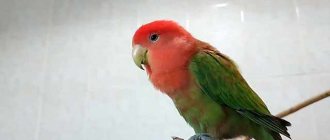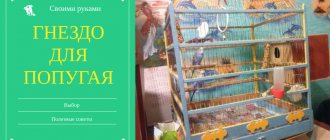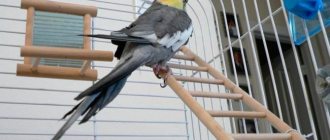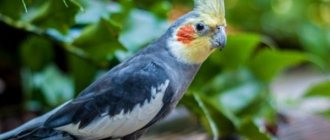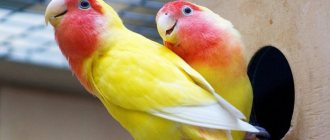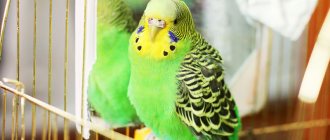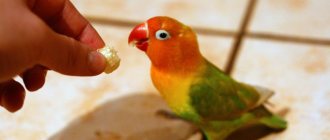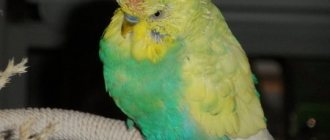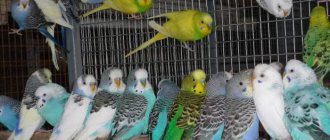Requirements
The bird needs enough space so that it can calmly spread its wings.
The more time the parrot spends in the cage, the larger the structure should be. If the owner practices frequent walking of the pet - free flights, then the size is not so critical.
The shape of the cell is also of great importance. "Skyscrapers" and "domes" are more suitable for songbirds and large representatives of parrots.
Lovebirds prefer to move in a horizontal plane rather than a vertical one.
The ideal cage solution for lovebirds is a rectangular cage. Rounded options can confuse the bird's orientation in space. In addition, lovebirds need a corner where they will feel safe.
The species received its name due to its special character. Lovebirds choose a mate for life. And if the partner dies for some reason, then the bird no longer makes attempts to find a replacement for him.
Particular attention should be paid to the material from which the cage is made. Considering that lovebirds use their beaks to test the strength of everything and everyone, it is better to abandon the tree. After 3-4 months, bare rods will remain from the cage.
It would be better to stick with plastic. But it must be of high quality. Cheap solutions emit toxic fumes, especially during the hot summer months. The rods must be chrome or nickel plated. Copper is excluded because it oxidizes and can harm the bird.
It is more practical to choose a cage with a retractable tray. Lovebirds quickly get used to people, but at the same time they are sensitive to personal space. Hands flashing in the cage will cause the bird to become stressed, which will negatively affect not only its attitude towards its owner, but also the health of the pet. In addition, cleaning a pull-out tray is much more convenient than a solid one.
How many parrots do you have?
12
Dimensions
The minimum dimensions of the cage are 60 x 30 x 60 cm, provided that the bird periodically leaves it for free flights. Otherwise, you should look for a larger solution. The optimal option for a pair of parrots is 80 x 40 x 90 cm. In such cages you can place not only the required attributes, but also toys.
The maximum distance between the rods is 1.5 cm. Lovebirds are very curious and active birds. They will definitely try to crawl between the bars, which can lead to injury.
Designs that are too bulky are dangerous for small birds. The parrot will try to fly around the cage, which greatly increases the risk of injury to its wings and paws.
Equipment
All accessories must be safe for birds, that is, sharp objects must be completely excluded. You should also avoid excessively small equipment, for example, beads. A parrot may accidentally swallow them if they are playing around.
Mandatory attributes of a cage for lovebirds:
- perches;
- drinking bowl;
- feeder;
- swimsuit
Toys are a variable accessory. When kept in pairs, they entertain themselves. If the bird is alone, then toys must be present, otherwise the bird will begin to become stressed from loneliness. The classic option for filling a medium-sized cage is a ladder, a swing, a bell and beads.
You can find modular play areas on sale. They are installed next to the cage and, if necessary, supplemented with independent modules. With such a playground, your pet will definitely not get bored.
The perches must be of the correct diameter - from 1.5 to 2 cm. The bird simply will not sit on smaller bars, and solutions that are too large will negatively affect the development of the bird’s paws. Unlike a cage, the optimal material for perches is wood. It’s good if the surface is uneven, then the bird’s grip will be much more comfortable.
There should be at least a couple of perches per parrot. In this case, one crossbar is used as a perch. In the absence of sepia and other mineral stones, it would be useful to acquire a concrete perch. It will serve not only as a perch, but also as a tool for grinding down the beak and claws.
The photo shows one of the options for a house for a couple:
There should be two feeders: one for dry food, the other for cereals. Holders for fruits and vegetables also come in handy. The latter should not be on the pallet, because they will quickly mix with feathers, fluff and other dirt.
Newspapers, magazines and other printing materials cannot be placed on the pallet, as they contain toxic ink. The best option is a special filler, sawdust or simple printer paper.
It is also useful to read: Cage for a budgie
Cage dimensions
The main question when buying a feathered family member is what kind of cage is needed for a lovebird. The minimum dimensions are 80/30/40 cm per bird, the larger the size, the better. The parrot must be able to actively move, spread its wings freely, and fly from perch to perch. In cramped conditions, a pet will quickly develop health problems, especially if the owner rarely lets it fly.
Popular sections:
Aquariums Sale of kittens and puppies Terrariums Products for cats Products for dogs
House care
The cage must be looked after every day. A typical procedure includes cleaning the tray, drinking bowl, feeder, perches and toys. General cleaning is required every 10 days. In addition to cleaning accessories with water, they should be treated with a disinfectant solution/spray.
You can buy such products at almost any pharmacy. The main thing is that the drug does not have a prolonged effect, otherwise the active substances will enter the parrot’s gastrointestinal tract and cause serious poisoning. During general cleaning, the cage itself must also be thoroughly washed and treated with a disinfectant.
Bathing
Birds love to swim. Water procedures are a necessity. Lovebirds have no other way of cleaning their feathers from dust and grease.
Any bowl with sides no higher than 3 cm is suitable for swimming. The water temperature should not exceed +27 degrees Celsius, sometimes it will have to be heated or, conversely, cooled. Baths should be organized in a warm room.
It is important to ensure that the wet individual does not fall into a draft.
Where can I buy
The cages are sold in both offline and online pet stores. Key characteristics that influence the price are dimensions, materials used and equipment. It is better to buy toys separately, because when included they significantly add to the cost of the cage.
The price range is quite large. Small cells made of high-quality material will cost 2-3 thousand rubles. More spacious and well-equipped ones cost more than 6,000. Prices for premium options with high-quality coating start at 10 thousand rubles.
Well-established cell manufacturers:
- Ferplast (Italy);
- Hagen (Canada/Germany);
- Tesoro (China);
- Inter-Zoo (Poland);
- Triol (China).
Leisure, games, communication
Parrots love to communicate, play and interact in every possible way with other birds and humans. They are easy to train. If desired, they can be trained to dance, juggle rings and perform other tricks. But you need to start your leisure time, communication and training with any pet by accustoming it to human hands. The best way to do this is with treats. At the same time, birds need to be trained to handle from a young age.
Attention! When training your pet to handle, you should not touch the parrots’ legs or wings. They perceive such actions as the beginning of a fight. Therefore, aggression occurs.
Birds need communication constantly. It is advisable that they communicate with both humans and other birds. Communication is an important component of proper care and maintenance of lovebirds at home. After all, domestic parrots often suffer from loneliness. For this reason, it is better to keep lovebirds in pairs. A person should communicate with birds quietly, without sudden movements. It is difficult to teach lovebirds to speak, since they usually remember about 10 words.
How to make it yourself
In order not to invent a bicycle, it is more advisable to turn to ready-made options. Manufacturers of premium solutions always provide their products with a more or less detailed design diagram, which indicates key elements with dimensions.
That is, it is enough to scan the document and, using it as a basis, assemble the cage on your own. Naturally, the main materials will not be factory-made plastic and coated rods, but wood and fine mesh.
Form
The store catalog presents many designs of different shapes. Round and cylindrical cages, as well as models with an original roof, are considered the most fashionable and popular.
But such cages are inconvenient and impractical: they are difficult to maintain and clean. In addition, in such a house the pet is guaranteed constant stress, which will lead to health problems, self-plucking and other troubles. When choosing a cage for lovebirds, remember a few simple rules:
- carefully inspect the structure, make sure it is reliable and there are no sharp elements;
- the best shape for lovebirds: rectangular. In such a cage the pet feels calm, the corners give a feeling of security, the space allows you to move in a horizontal position;
- refuse cages with a wooden base - lovebirds will quickly render it unusable;
- A rounded or flat roof is considered successful.
Does a lovebird need a mate?
Exotic lovebirds got their name from a beautiful legend. According to it, birds choose a couple of times in their lives, touchingly care for each other and languish with melancholy if they lose a partner. However, this is just a legend; in fact, the mate is not important to the lovebird. If you are in doubt about whether to get only one parrot, feel free to decide. In the same way, you can add a new pair to a lovebird who is left alone.
The decision to have one parrot should be made consciously. A pair of lovebirds will never be bored; the birds keep themselves busy. If the lovebird lives alone, you will need to devote more time to him and entertain him. If the bird will often have to be left alone and will rarely communicate with it, then it is better to get a pair of lovebirds.
Difficulties
Now let's talk about the main problems. After all, various kinds of difficulties often arise when breeding lovebirds.
It may happen that none of the eggs will contain an embryo. What to do then? Do not take away the eggs under any circumstances. This can have a very bad effect on the female's emotional state.
What to do with a large clutch, when there are few eggs without fruit? Then nothing bad will happen if you carefully remove the pacifiers.
Sometimes embryos in fertilized eggs die. This may happen in the following cases:
- The female was absent for a long time and did not sit on eggs for a long time.
- There are problems with ventilation in the nest and poor access to fresh air.
- The female's body lacks vitamins.
- Parasites appeared on the mother's body.
In the latter case, you need to treat the parrots, the cage and all objects in it with special means. If there is a lack of vitamins, it is necessary to replenish their balance by giving the lovebird vitamin and mineral complexes. It will be possible to reproduce the pair only a year after the problem is solved.
Sometimes chicks that have already been born die. The cause of death of young chicks may be the following:
- One of the parents showed aggression.
- The offspring lack food and warmth.
A parrot may die if its mother plucks its feathers. This happens when the female’s body lacks calcium.
When creating a second clutch, female lovebirds sometimes throw small chicks out of the nest. Your task is to have time to separate the offspring and start feeding them independently.
Description
This genus is part of the parrot family of the order Psittacidae. Lovebirds reach a length of 0.1-0.17 m. The wingspan is 0.04 m, the tail extends 0.06 m. The weight of the bird is from 0.04 to 0.06 kg. The head is relatively large.
Most often the feather is green. However, individual areas (tail, chest, head and neck) may be painted in different colors. Occurs:
- red;
- blue;
- yellow;
- pink and other colors.
The beak itself is colored either bright red or straw yellow. The tail is not too long, nor are the legs. This does not, however, prevent the parrot from moving quickly on the ground and even climbing trees.
Lovebirds live in the forests of the tropics and subtropics; there are also species that inhabit steppe and mountainous areas. They are characterized by a gregarious way of life. The flight of these parrots is very fast and stable. At night, birds sit on tree branches or cling to small twigs. There are mentions that different flocks can enter into a fight for already occupied trees.
According to some reports, the homeland of lovebirds is South-West and South-East Africa, Madagascar. Nesting occurs in hollows. There the birds only lay out their bedding. But occasionally lovebirds build nests. Construction is proceeding very efficiently.
To build a nest, birds need:
- small twigs;
- blades of grass;
- bark fragments.
It is curious that different species in this genus can transport collected building material in different ways. Some carry it in their beaks, while others fly, delivering the same twigs under their feathers. The clutch consists of 4-8 eggs. Hatching time is 21-25 days. The name “lovebirds” stems from the idea that if one of a pair of birds dies, the other will soon die.
But this is rather a myth, it just takes some time before a new family appears. The flocks are relatively small, each containing several couples. Very often, lovebirds are drawn to farms that provide them with food. Birds eat seeds and berries.
Diet
How to care for lovebirds? This is a question many breeders ask.
It is important to note that the basis of bird health is proper nutrition.
They should eat a mixture of seeds and grain or ready-made food. To make food for birds at home, you need to make a mixture:
- sunflower seeds;
- oatmeal;
- corn;
- millet;
- canary seeds;
- oat grain.
This mixture should be given to birds in the amount of one large spoon. Birds should also be fed a mixture of fruits (apples, blueberries and currants), grass (dandelions, clover and nettles) and parsley in the amount of two small spoons per day. The cage should contain twigs, activated carbon and chalk. Once every seven days you should feed them a hard-boiled egg with cottage cheese.
Attention! Some tropical fruits and candied berries should not be given to your pet lovebird. Contraindicated: avocado, mango and persimmon
The role of mineral supplements
What should you feed your lovebird to provide it with all the nutrients? The main addition to the parrots' diet will be mineral supplements. The deficiency of useful microelements can be compensated with the help of crushed eggshells. However, before grinding and adding to the food, it must be boiled or calcined in the oven.
Chalk can be given as additional mineral elements. It contains calcium.
Feed chalk for birds is sold at the pet store.
When caring for lovebirds, it is important to pay attention to their well-being in order to notice any deviations in time and review their diet, including food rich in vitamins and minerals. This is the only way to understand what to feed parrots that will benefit their health.
If the question concerns the rate of water consumption, then it should always be in the drinking bowl. It is recommended to boil tap water and add fresh water daily. Parrots like juices from fresh berries and fruits, so sometimes they can be given freshly squeezed juice, but in small doses.


